Selling products online offers a vast landscape of opportunities, ranging from expansive marketplaces to niche platforms, each presenting unique advantages and fee structures. While marketplaces provide immediate access to a broad customer base, establishing your own online store grants greater autonomy and the potential for higher profits, unburdened by external platform fees and limitations. Platforms like Shopify stand out as user-friendly solutions for building a personalized online store, enabling seamless integration with various marketplaces and social media channels to broaden your reach. Ultimately, a strategic blend of marketplace presence and a dedicated online store is key to maximizing brand growth and profitability in the online selling arena.
The internet is brimming with diverse places to sell items online. From specialized sites focusing on collectibles or crafts to expansive marketplaces hosting everything from apparel to electronics, the options are plentiful. Navigating this landscape requires understanding the nuances of each platform to make informed decisions for your business.
While online marketplaces offer undeniable benefits like built-in audiences and streamlined selling processes, sellers must carefully weigh factors such as transaction fees, listing limitations, and brand visibility. These elements can significantly impact profitability and long-term business growth.
Below, we delve into the leading Online Selling Sites of 2024, explore the advantages of creating your own online store, and discuss how a synergistic approach combining both strategies can significantly amplify your sales potential.
Building Your Own Online Store: Take Control
 The Dawn Shopify theme is edited using the Shopify store builder
The Dawn Shopify theme is edited using the Shopify store builder
Alt text: Editing the Dawn theme in the Shopify store builder interface, showcasing customization options for online store design.
Creating your own online store can be exceptionally rewarding, offering a direct pathway to higher profit margins compared to relying solely on marketplaces. When executed strategically, an independent e-commerce store empowers you to cultivate a distinct brand identity and customer experience.
Operating your own e-commerce store eliminates per-sale fees and liberates you from adhering to the specific rules and regulations imposed by external platforms. This autonomy translates to greater control over your business operations and customer interactions.
Shopify emerges as a leading platform for simplifying online store creation. As a comprehensive ecommerce platform, Shopify equips sellers with the tools to swiftly launch and manage their online businesses with minimal upfront investment and without requiring advanced technical expertise.
The process of creating a store with Shopify is streamlined through an extensive library of over 100 pre-designed website templates. Each Shopify store is equipped with essential features including a secure checkout, SSL security certifications, and user-friendly marketing tools to kickstart your sales efforts.
Shopify’s versatility extends to omnichannel selling, allowing you to manage and sell directly on your website, across major marketplaces like Amazon and eBay via channels, and through social media platforms—all centrally managed from your intuitive Shopify dashboard.
Set up your store today and take the first step towards building your independent online selling presence.
Top Websites to Sell Products Online in 2024
eBay
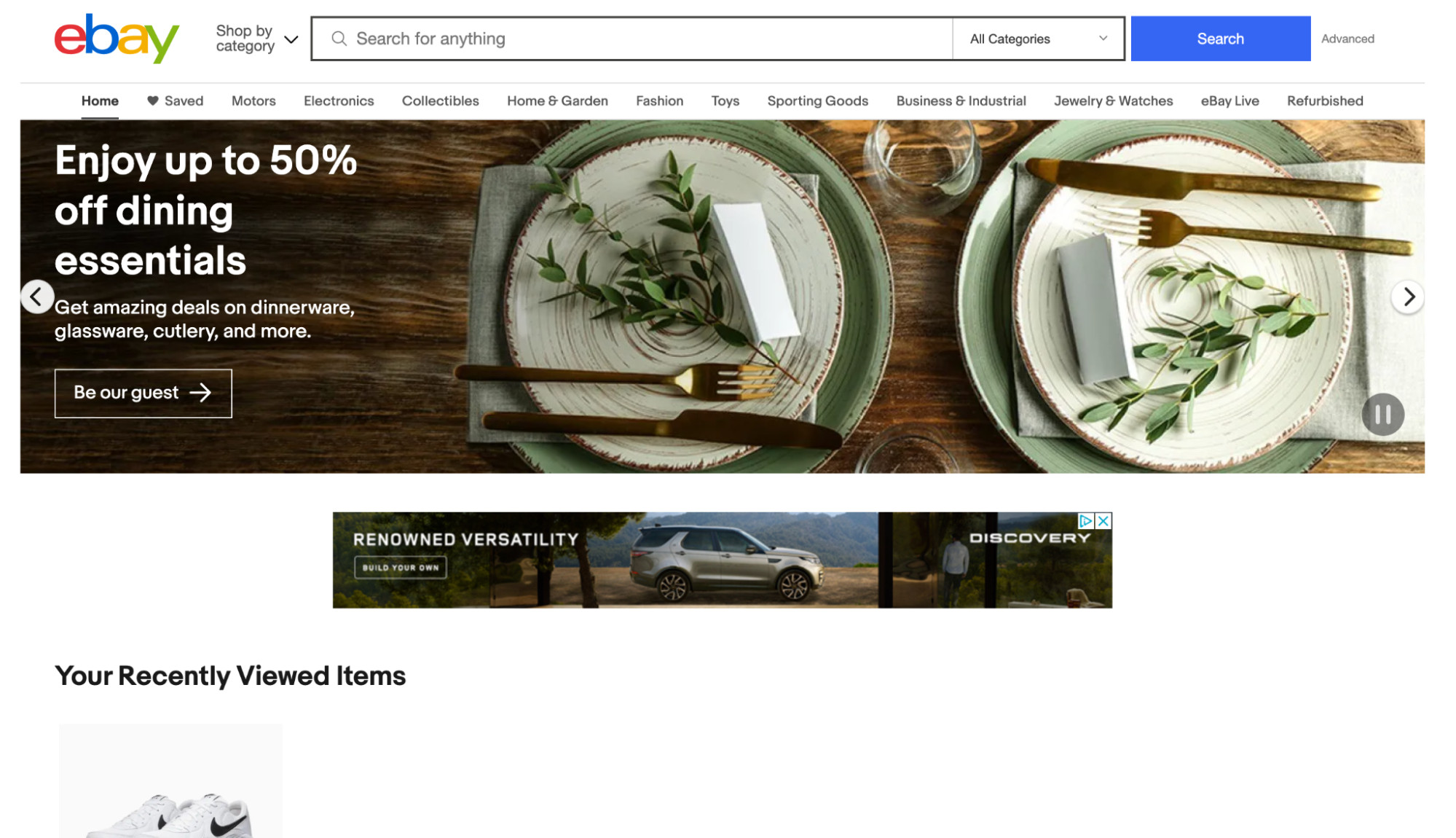 Ebay homepage with banner advertising dining sets, showing gold-rimmed plates, knives, and forks.
Ebay homepage with banner advertising dining sets, showing gold-rimmed plates, knives, and forks.
Alt text: eBay homepage displaying a banner ad for dining sets, featuring gold-rimmed tableware, highlighting home and living product categories on the online marketplace.
eBay stands as a pioneering force in online selling, introducing the concept to a global audience and maintaining its position as a market leader. Established in 1995, eBay remains a vibrant marketplace boasting over two billion active listings and a substantial base of 133 million active buyers worldwide.
eBay’s diverse marketplace accommodates a vast spectrum of products, from everyday essentials like apparel and accessories to niche and unusual items. Its extensive reach and established auction and fixed-price formats provide sellers with flexible selling options and access to a continuous stream of motivated buyers. Integrating eBay as a sales channel for your online store can significantly expand your market presence.
eBay Fees
Understanding eBay’s fee structure is crucial for sellers planning to sell on eBay. The platform employs a multi-tiered fee system, including a non-refundable listing fee per product and potential insertion fees for duplicate listings in different categories. Furthermore, eBay levies a final value fee, typically ranging from 10% to 15%, calculated on the total sale amount, encompassing shipping and handling charges. These fees should be factored into pricing strategies to ensure profitability.
Bonanza
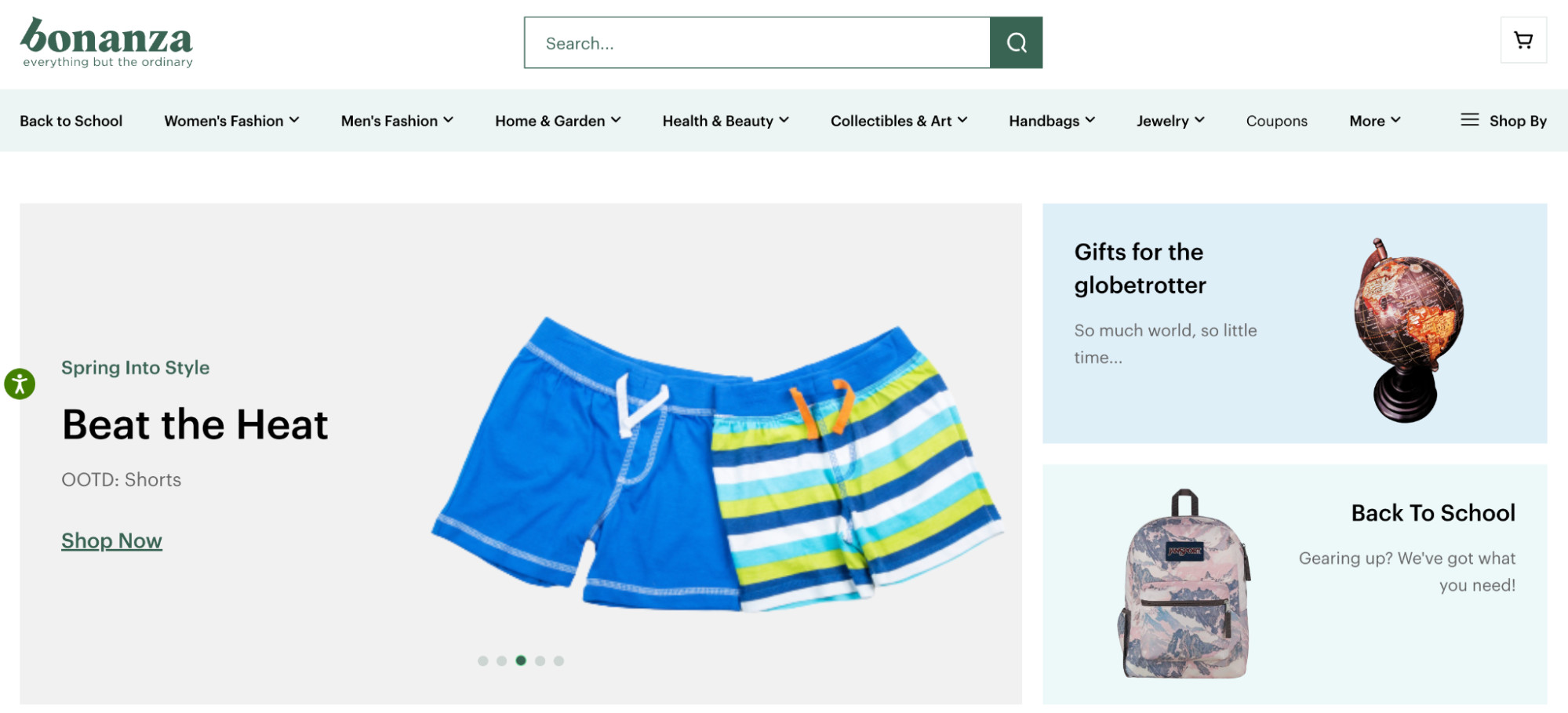 product cards showing swim shorts, a backpack, and a model globe, below a nav bar and menu.
product cards showing swim shorts, a backpack, and a model globe, below a nav bar and menu.
Alt text: Bonanza product category display featuring product cards for swim shorts, a backpack, and a globe, showcasing diverse product offerings on the online selling platform.
Bonanza is gaining traction as a compelling online selling site, particularly as an alternative to eBay. This Seattle-based platform supports a wide array of product categories and attracts nearly 1.5 million monthly website visits, indicating a growing and engaged buyer audience.
Bonanza occupies a unique space between major marketplaces like Amazon and eBay, offering a blend of product types. While it features a selection of branded items, Bonanza is particularly known for its emphasis on unique, handmade, and vintage goods. This positioning attracts buyers seeking distinctive items beyond mainstream retail offerings. Bonanza’s platform allows for both fixed pricing and buyer-initiated offers, providing sellers with flexible pricing strategies and direct negotiation capabilities. Integration with platforms like Shopify simplifies product management and expands selling capabilities for businesses already operating their own online stores.
Bonanza Fees
Bonanza distinguishes itself with a seller-friendly fee structure. Listing products on Bonanza is free, and the platform only charges a small percentage-based fee on the final sale price after a successful transaction. This commission-based model aligns seller interests with platform success, fostering a supportive environment for online businesses.
Ruby Lane
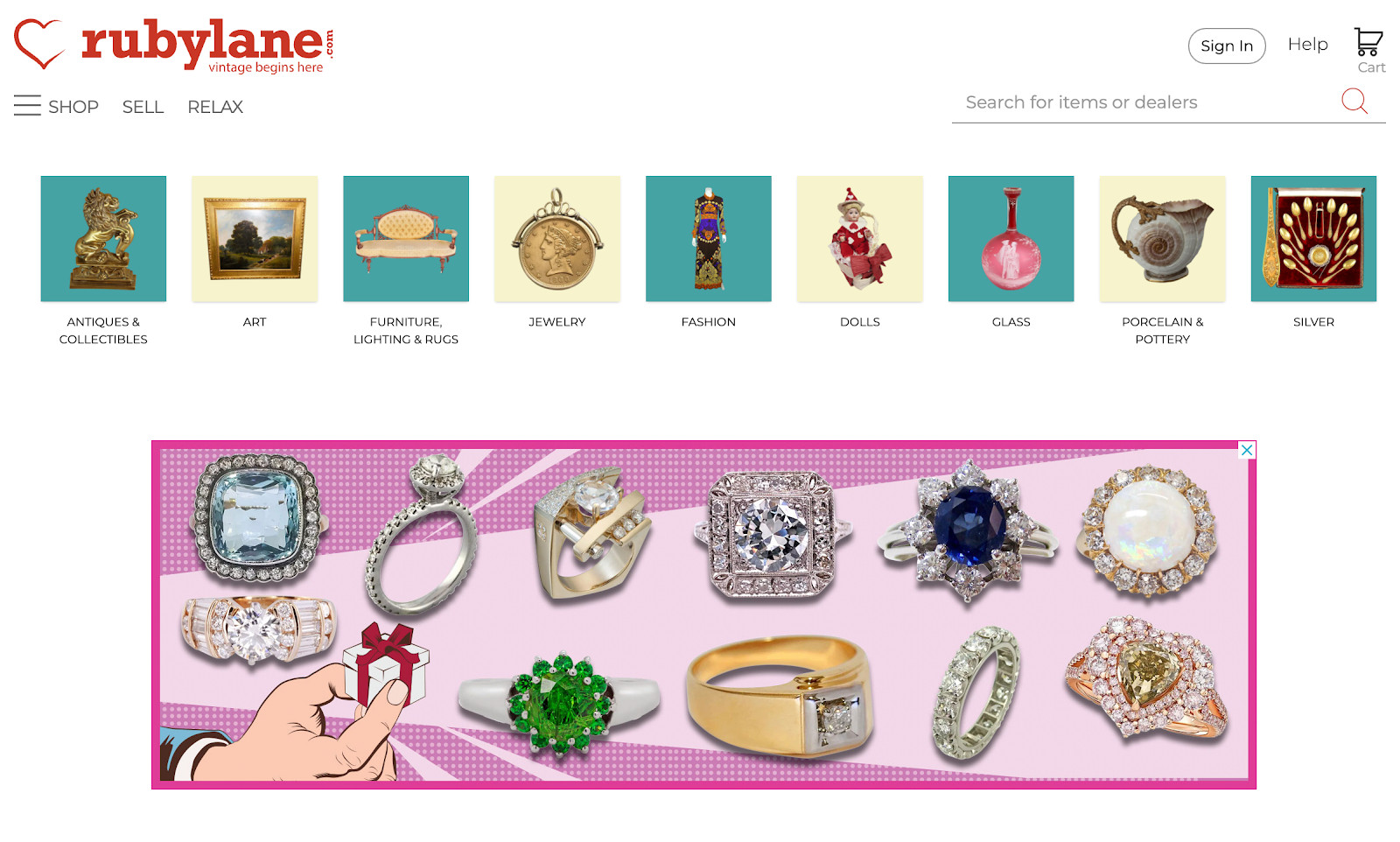 Diamond rings on a pink background. A carousel of antiques categories like art, furniture, and glass.
Diamond rings on a pink background. A carousel of antiques categories like art, furniture, and glass.
Alt text: Ruby Lane marketplace showcasing diamond rings against a pink backdrop and a carousel of antique categories including art, furniture, and glass, highlighting its focus on vintage and collectible items.
Ruby Lane is a premier online marketplace specializing in vintage and antique items. This platform caters to a niche but highly engaged audience of collectors and enthusiasts seeking unique, high-value items. Selling on Ruby Lane provides direct access to targeted buyers interested in categories such as antiques, collectibles, vintage fashion, art, dolls, and jewelry.
Ruby Lane serves as an ideal platform for antique dealers, vintage store owners, and individuals specializing in high-end collectibles. Its focus on quality and curated selection differentiates it from broader marketplaces, attracting serious buyers and fostering a community passionate about vintage and antique treasures.
Ruby Lane Fees
Ruby Lane’s fee structure is transparent and straightforward. While listing products is free, sellers are required to pay a monthly maintenance fee of $45 to maintain their shop presence. Additionally, Ruby Lane charges a 9.9% service fee based on the total purchase order value, with a cap of $2,500 per transaction. This fee structure is designed to support the platform’s curated environment and targeted marketing efforts towards serious collectors.
Etsy
 A pink product carousel featuring images of a necklace, candle, ring, key ring, and greeting card.
A pink product carousel featuring images of a necklace, candle, ring, key ring, and greeting card.
Alt text: Etsy product carousel in pink hues, featuring handcrafted items like a necklace, candle, ring, keyring, and greeting card, emphasizing its focus on handmade and creative goods.
Etsy is the go-to online selling site for handcrafted, vintage, and unique creative goods. Originally focused exclusively on handmade and vintage items, Etsy has expanded to include select maker-developed manufactured goods, broadening its appeal while maintaining its core identity. With over 96 million active buyers, Etsy provides sellers with a substantial and engaged customer base actively seeking unique and artisanal products.
Etsy offers new online sellers a supportive ecosystem with an active buyer network, marketing tools, and resources to establish and grow their businesses. Its platform is particularly well-suited for artisans, crafters, and vintage sellers looking to connect with customers who appreciate unique, handcrafted items and personalized shopping experiences.
Etsy Fees
Etsy’s fee structure includes a $0.20 listing fee per item, regardless of whether it sells. Listings automatically expire every four months, requiring renewal and incurring another $0.20 fee if the item remains unsold. Upon a successful sale, Etsy charges a transaction fee of 6.5% of the display price, plus shipping and gift wrapping fees. These fees are essential considerations for sellers when pricing their products on the Etsy platform.
Explore popular Etsy alternatives for expanding your reach and diversifying your online selling strategy.
Chairish
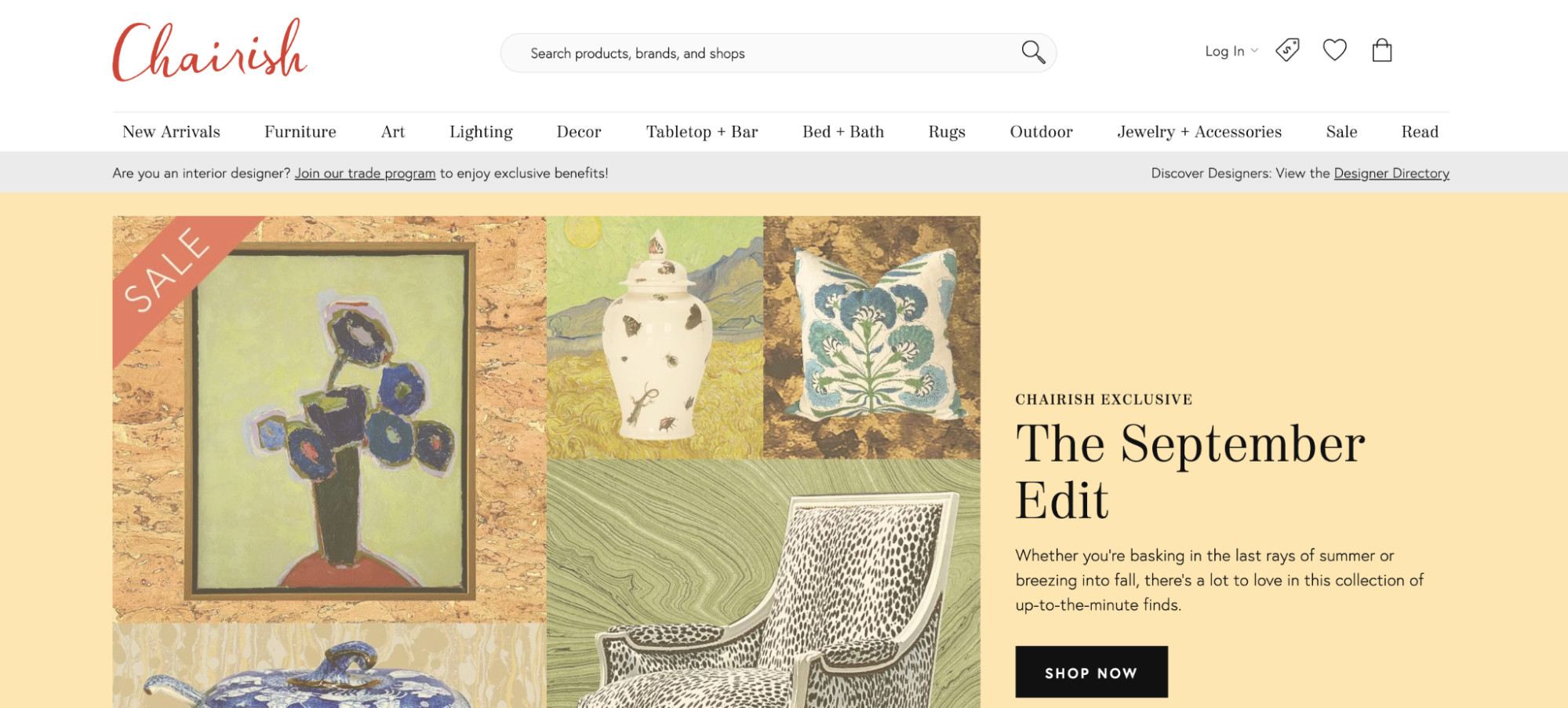 A yellow homepage with illustrations of a boutique chair, throw cushion, ceramic pot, and painting.
A yellow homepage with illustrations of a boutique chair, throw cushion, ceramic pot, and painting.
Alt text: Chairish homepage in yellow tones featuring illustrations of design-focused furniture and decor items like a chair, cushion, pot, and painting, highlighting its specialization in high-end home furnishings.
Chairish operates as an online consignment marketplace specializing in high-end, design-oriented home decor and furniture. This platform connects sellers with discerning buyers seeking premium and curated home furnishings. Listing items on Chairish is free and streamlined, allowing sellers to quickly showcase their pieces to a relevant audience. Depending on the chosen seller plan, sellers retain between 70% and 80% of the selling price, offering a competitive commission structure for valuable items.
Chairish is particularly effective for businesses and individuals dealing in design-centric furniture, art, and home decor. Its curated environment and focus on quality attract affluent buyers and streamline the process of selling high-value home goods online.
Chairish Fees
Chairish offers both free and paid seller plans with varying commission rates based on product type and plan tier. A unique aspect of Chairish is its curatorial team, which reviews listings to ensure they meet the marketplace’s standards of quality and design. Chairish also manages shipping logistics, simplifying the selling process for vendors and removing the complexities of handling furniture delivery.
Swappa
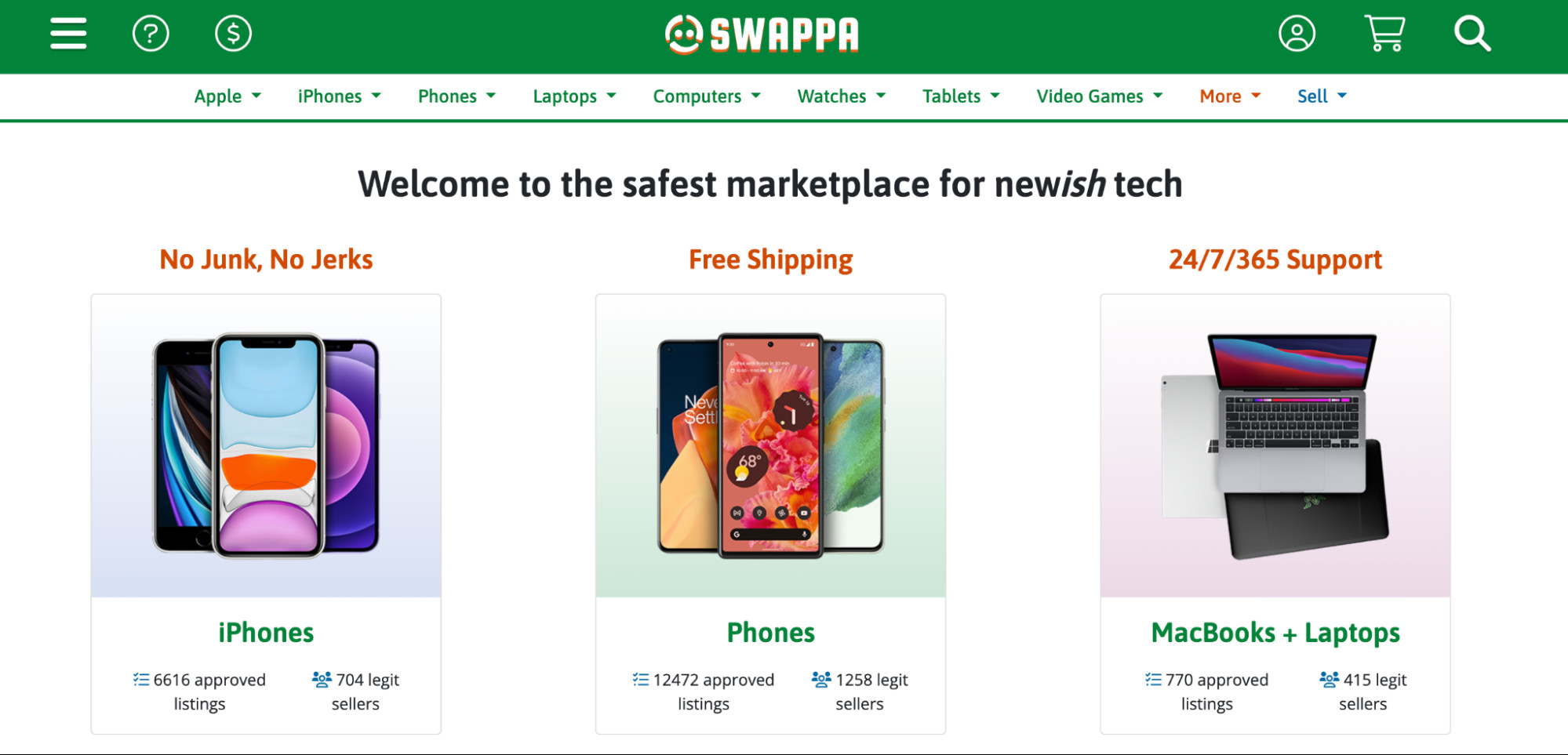 Three products cards with pictures of iPhones, smartphones, and laptops.
Three products cards with pictures of iPhones, smartphones, and laptops.
Alt text: Swappa product listings display featuring iPhones, smartphones, and laptops, showcasing its focus on used and refurbished tech gadgets for online selling.
Looking to sell pre-owned tech devices? Swappa is a dedicated buy-and-sell website for used phones, laptops, cameras, and other electronics. This platform provides a secure and streamlined marketplace for selling and purchasing used technology.
Swappa distinguishes itself by vetting all products listed on its marketplace, ensuring that items are in good working condition and accurately represented. This commitment to quality and functionality builds trust between buyers and sellers. Payment processing is secured through PayPal, adding an extra layer of protection for transactions.
Swappa Fees
Creating listings on Swappa is free, offering sellers a cost-effective way to showcase their tech devices. For enhanced visibility, sellers have the option to feature their listings for a $5 fee. Upon a successful sale, Swappa charges a 3% fee, which is shared between the buyer and the seller, maintaining a balanced and transparent fee structure.
Poshmark
 A person presenting a pink tie-dye sweater on a hanger during a live stream filmed on a smartphone.
A person presenting a pink tie-dye sweater on a hanger during a live stream filmed on a smartphone.
Alt text: A Poshmark seller showcasing a pink tie-dye sweater on a live stream using a smartphone, highlighting the platform’s social commerce features for clothing sales.
Poshmark is a leading social commerce marketplace specializing in clothing, fashion accessories, and lifestyle items. Launched over a decade ago, Poshmark has cultivated a vibrant community of buyers and sellers centered around fashion and personal style.
With over 80 million registered users, Poshmark offers sellers access to a large and engaged community of fashion-conscious buyers. The platform’s social features enable sellers to actively promote their items, participate in virtual “Posh Parties,” and build relationships with potential customers. Poshmark sellers can also leverage social media integration to further expand their reach beyond the platform.
Poshmark Fees
Poshmark’s commission structure is tiered based on the sale price. For sales under $15, a flat commission of $2.95 is applied. For sales exceeding $15, Poshmark’s commission is 20%, as detailed in their FAQ. This fee structure should be considered when pricing items and evaluating profitability on the platform.
Decluttr
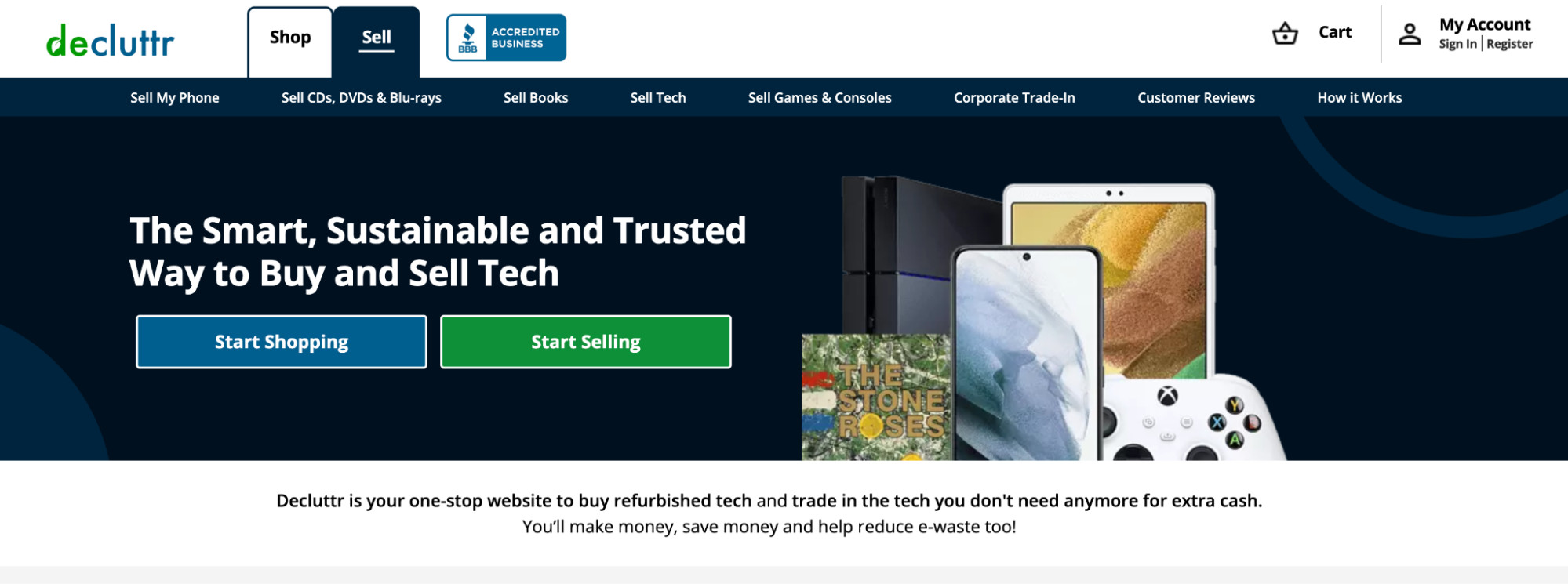 A collage of tech products, including an iPad and an XBox controller.
A collage of tech products, including an iPad and an XBox controller.
Alt text: Decluttr marketplace collage featuring various tech products like an iPad and an Xbox controller, demonstrating its focus on buying and selling used electronics and media.
Decluttr is another prominent platform focused on the electronics market, providing a convenient way to sell used tech gadgets, alongside books, game consoles, and other entertainment items. Decluttr simplifies the selling process by directly purchasing items from sellers.
Decluttr Fees
Unlike many marketplaces, Decluttr buys your electronics directly, eliminating the need for listings and direct buyer interaction. Sellers use the Decluttr app to scan the barcode of items they wish to sell to receive an instant quote. Decluttr covers all shipping costs and provides prompt payment upon receipt and verification of the items, offering a hassle-free selling experience.
Amazon
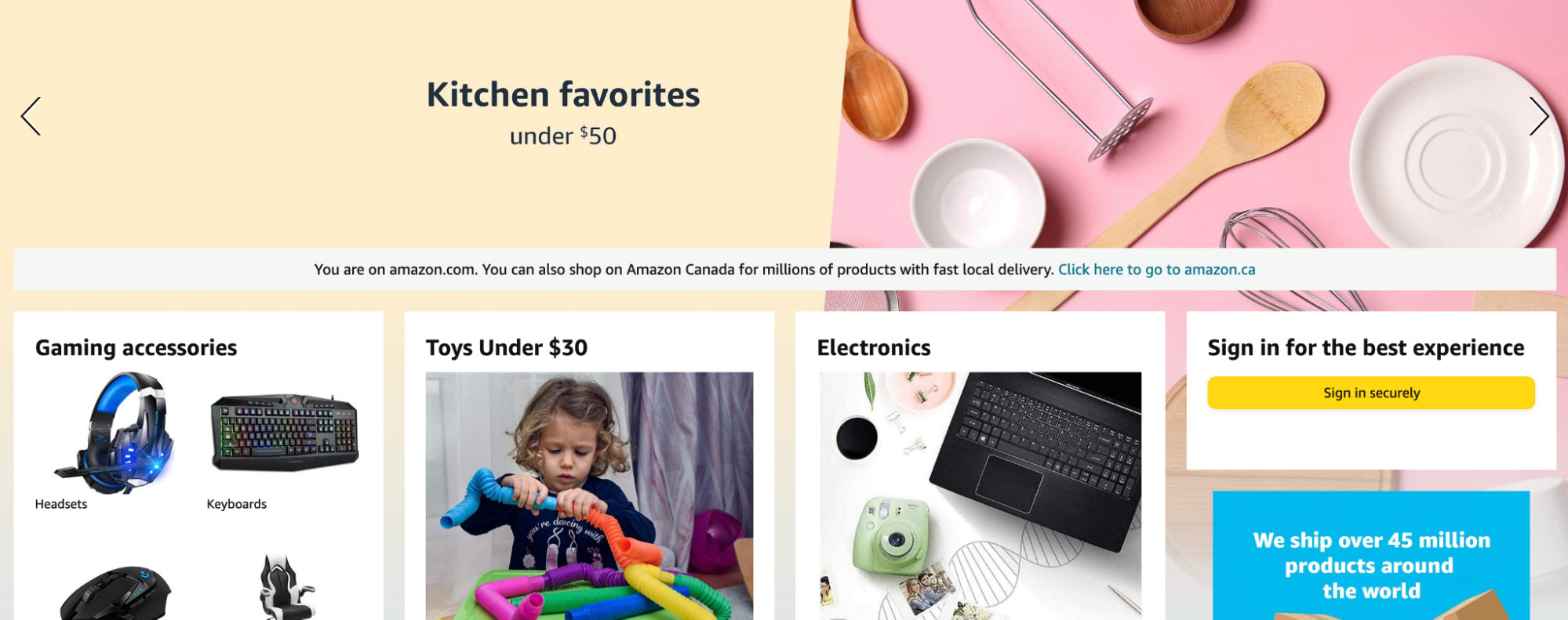 Amazon homepage with banner advertising kitchen products like spoons, bowls, and whisks.
Amazon homepage with banner advertising kitchen products like spoons, bowls, and whisks.
Alt text: Amazon homepage banner ad showcasing kitchen products such as spoons, bowls, and whisks, illustrating the vast product range available on this dominant online marketplace.
As global ecommerce sales continue their upward trajectory, Amazon remains the dominant and most widely recognized online selling site globally. Amazon pioneered the online marketplace concept and continues to reign supreme, attracting millions of buyers and sellers worldwide. Reports indicate that Amazon facilitates the sale of over 4,000 products per minute, providing sellers with unparalleled access to a massive, built-in customer base.
Amazon Fees
The cost to sell on Amazon is multifaceted, dependent on factors such as your chosen selling plan, product category, fulfillment strategy, and other variables. The basic Professional Seller plan incurs a monthly fee of $39.99, in addition to potential per-item selling fees, referral fees, and fulfillment costs. Understanding Amazon’s complex fee structure is crucial for sellers to accurately assess profitability and manage expenses.
Local Online Selling Sites: Connect with Your Community
For sellers aiming to target customers within their local communities, several online platforms facilitate local buying and selling, often for free.
Facebook Marketplace
 Iphone showing the Facebook Marketplace homepage on a blue background.
Iphone showing the Facebook Marketplace homepage on a blue background.
Alt text: Facebook Marketplace homepage displayed on an iPhone against a blue background, showcasing its mobile-first interface for local buying and selling within the Facebook ecosystem.
Facebook Marketplace, integrated within the expansive Facebook platform, provides a robust online selling site for individuals to connect, buy, and sell items locally. With over one in three people in the US utilizing Marketplace monthly, it presents a significant opportunity for sellers to reach an active and geographically relevant audience. Listing on Facebook Marketplace is generally free, and Meta does not typically impose selling fees, although adherence to platform guidelines is required.
Facebook Marketplace’s integration with platforms like Shopify enables merchants to seamlessly synchronize inventory, advertise listings, and engage with local customers, bridging the gap between e-commerce stores and community-based selling.
Craigslist
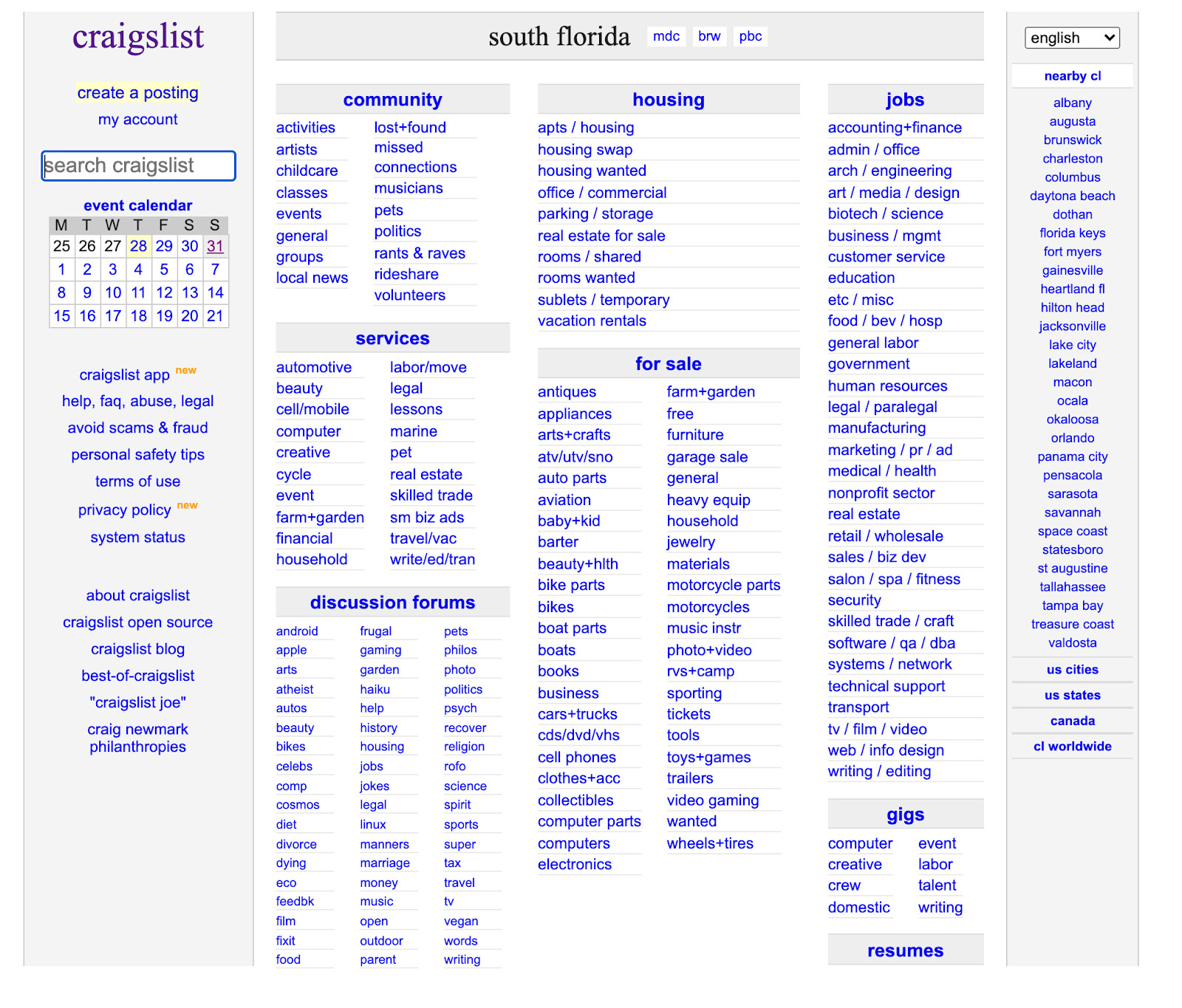 Lists of blue hyperlinked text with gray headings and gray sidebars.
Lists of blue hyperlinked text with gray headings and gray sidebars.
Alt text: Craigslist interface featuring lists of blue hyperlinked text, gray headings, and sidebars, illustrating its basic, text-heavy design as an early online classifieds platform.
Craigslist is a foundational online selling site, predating many contemporary marketplaces. Launched in 1995, Craigslist evolved from an email distribution list to a web-based platform spanning over 700 cities across 70 countries. While Craigslist remains free and widely accessible, its basic interface and limited features are not ideal for sellers aiming for scalable online sales operations. It functions primarily as a large local forum for classified listings.
Craigslist is recognized as a higher-risk online marketplace due to its hands-off approach to transactions. The platform’s limited moderation and lack of buyer/seller protections increase the potential for scams, and users have limited recourse for dispute resolution.
Nextdoor
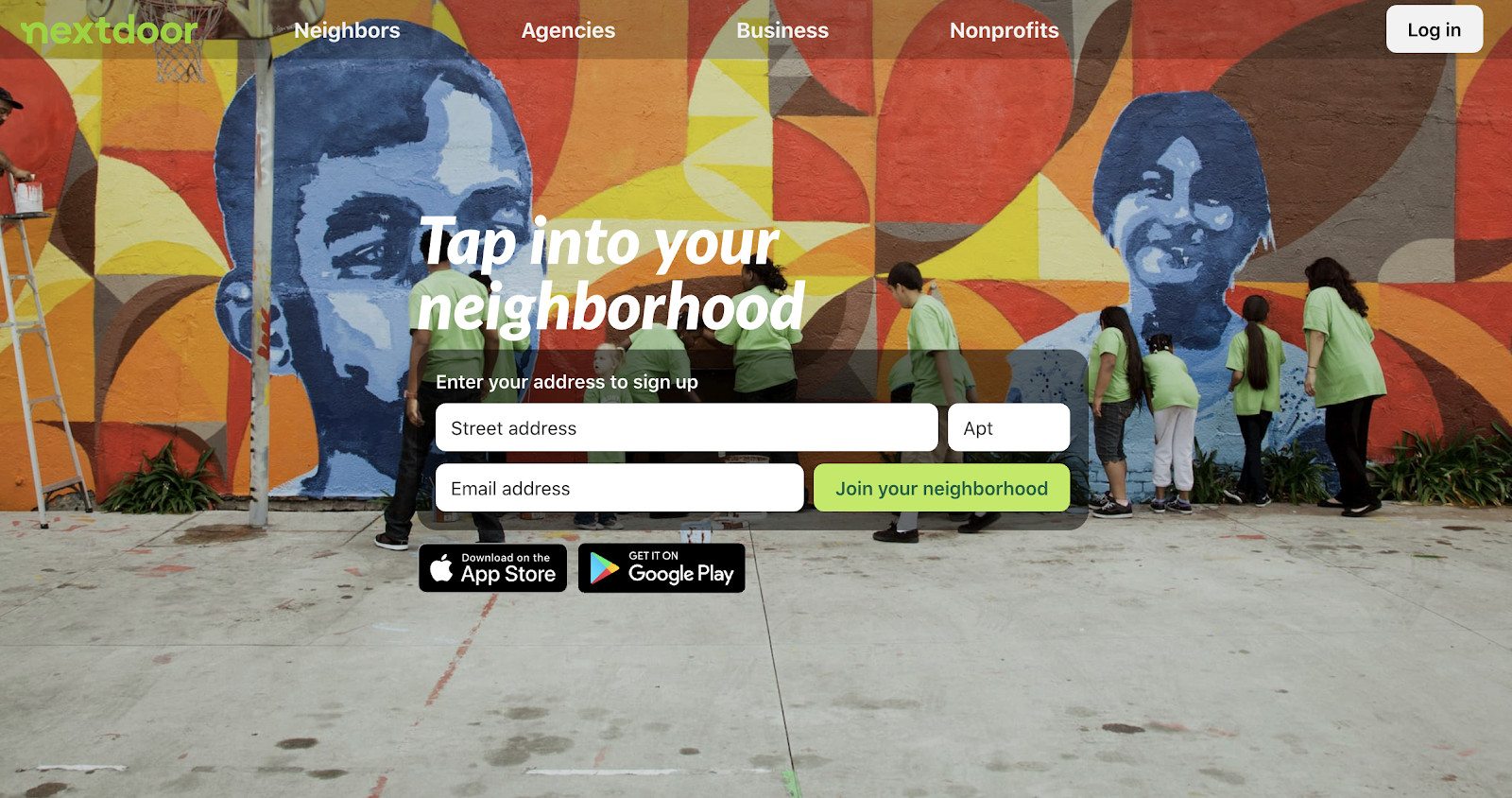 Local selling sites can help you offload large items link furniture or musical instruments.
Local selling sites can help you offload large items link furniture or musical instruments.
Alt text: Example of local selling on Nextdoor, showing large items like furniture and musical instruments being sold within a neighborhood context, emphasizing community-based transactions.
Nextdoor shares similarities with both Facebook Marketplace and Craigslist, focusing on facilitating community-centric selling. Nextdoor’s primary function is to connect neighbors, enabling localized discussions, recommendations, and community updates, fostering a neighborhood-oriented online environment.
Nextdoor provides a free platform for local online selling, mirroring Facebook Marketplace in its lack of listing fees and emphasis on in-person transactions. The platform’s account-based structure and neighborhood focus offer a perceived increase in safety compared to more anonymous platforms, as user verification is required for access.
VarageSale
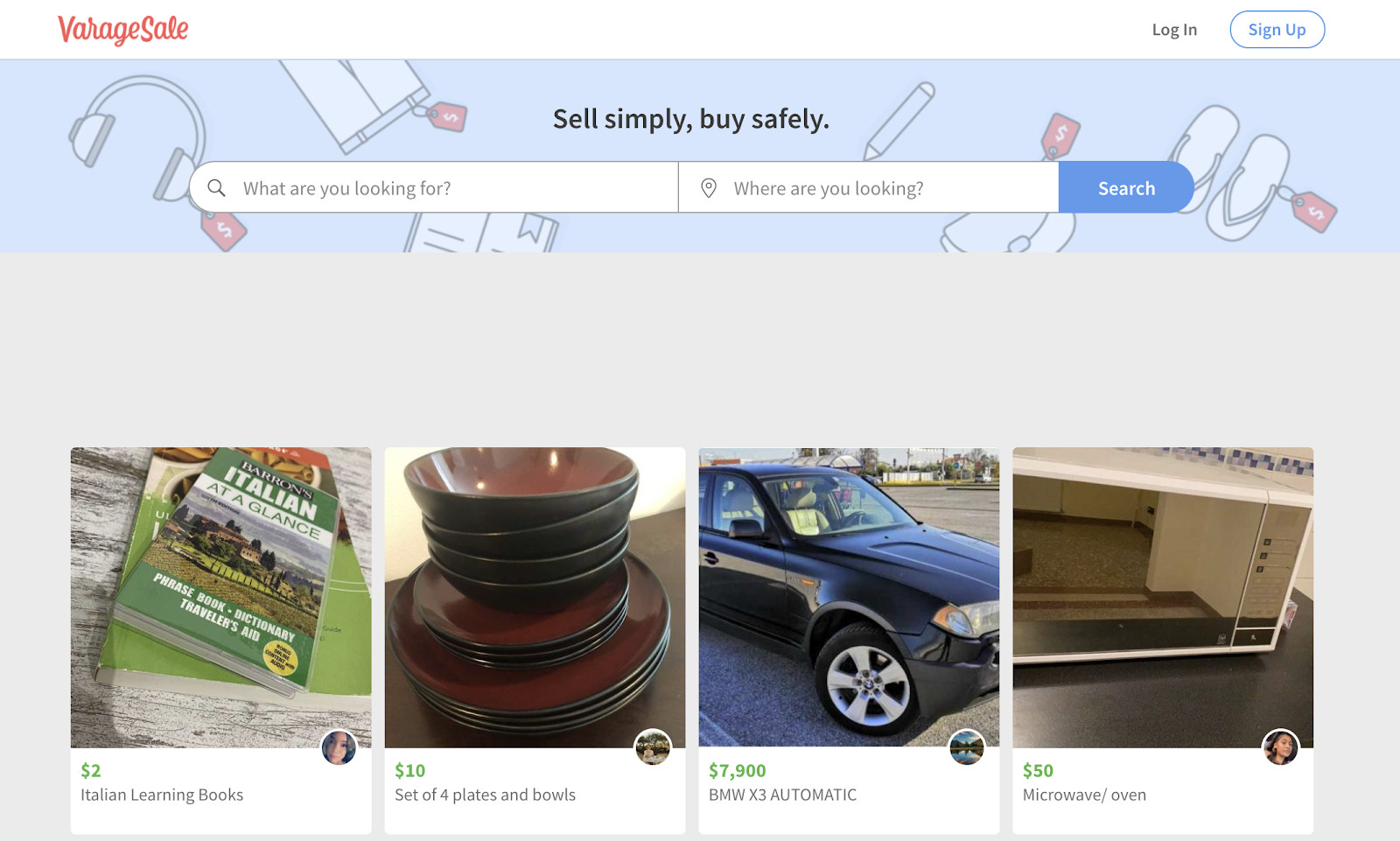 VarageSale’s manual ID confirmation process helps reduce fraud.
VarageSale’s manual ID confirmation process helps reduce fraud.
Alt text: VarageSale’s manual ID confirmation process highlighted on screen, emphasizing its security measures to reduce fraud in online local buying and selling.
VarageSale is a mobile-first “virtual garage sale” app designed for local buying and selling. Founded in Canada to address concerns about scams and fraudulent listings on other classified sites, VarageSale prioritizes user safety and authenticity. The platform employs a manual ID review process to verify user identities before granting buying or selling privileges.
VarageSale emphasizes community trust and transparency. Buyers can review seller ratings and communicate directly with sellers within the app to ask questions and arrange pickups. VarageSale supports the sale of diverse items, including furniture, clothing, and household goods, within a secure and community-focused environment, and is free for members.
Offerup
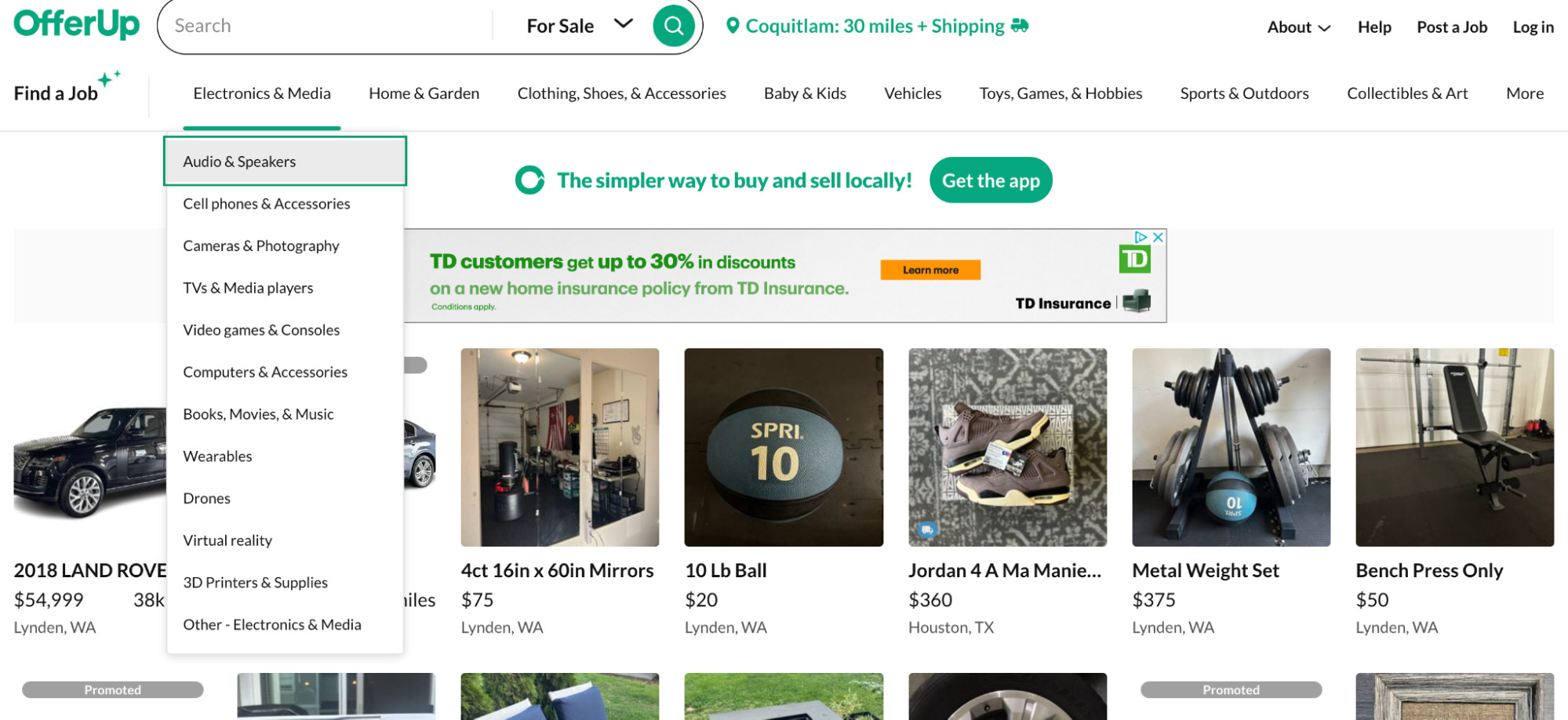 Catalog page for home gym equipment featuring product images and prices.
Catalog page for home gym equipment featuring product images and prices.
Alt text: OfferUp catalog page showcasing home gym equipment with product images and prices, illustrating its focus on local sales of various product categories including fitness equipment.
Offerup is a mobile marketplace that enables users to buy and sell a wide range of items locally, including electronics, clothing, and vehicles, based on geographic proximity. The platform facilitates direct communication between buyers and sellers through in-app messaging for price negotiation and meetup arrangements.
Similar to VarageSale, Offerup prioritizes user safety and security. The platform incorporates user profiles and review systems to enhance transparency and trust. Offerup also utilizes TruYou identity verification to further bolster user security and recommends community meetup spots to promote safer in-person transactions.
Best Global Online Selling Sites: Expand Your Reach Internationally
For sellers aiming to tap into international markets, several online marketplaces offer global reach and cross-border selling capabilities.
AliExpress
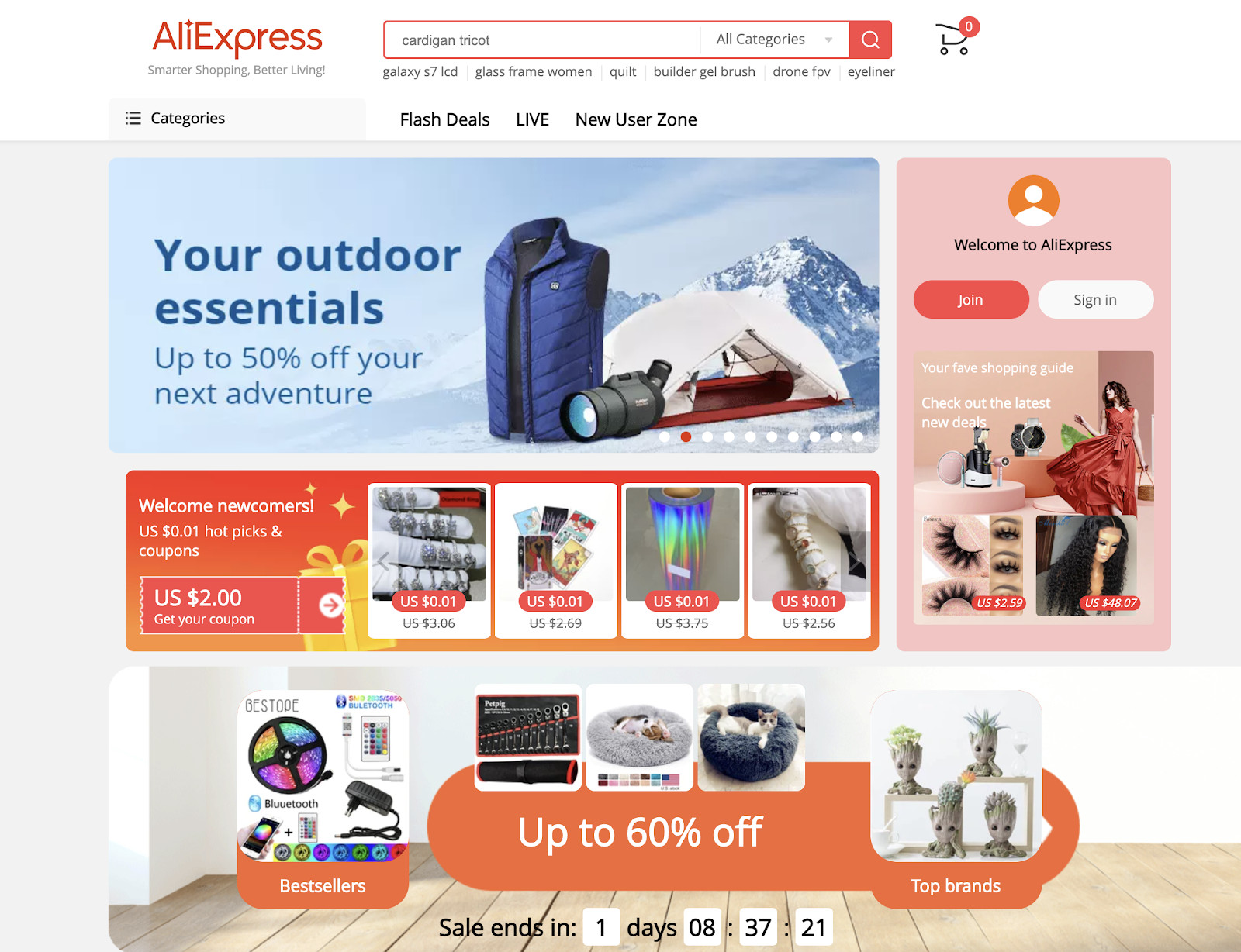 Collage of a vest, text, and torch on a background of blue mountains.
Collage of a vest, text, and torch on a background of blue mountains.
Alt text: AliExpress promotional collage featuring a vest, text elements, and a torch against a blue mountain backdrop, highlighting its global marketplace for diverse product categories and international sellers.
AliExpress, established in 2010 as Alibaba’s cross-border e-commerce marketplace, provides a platform for international selling with a substantial daily visitor count of nearly 20 million. AliExpress caters to both individual consumers and businesses, supporting diverse seller models, including manufacturers and those utilizing AliExpress dropshipping for their online stores.
AliExpress’s commission fees range from 5% to 8% per transaction, varying based on product category. Beyond these commission fees, AliExpress generally does not impose additional overhead or setup fees, making it an accessible platform for international sellers.
Taobao
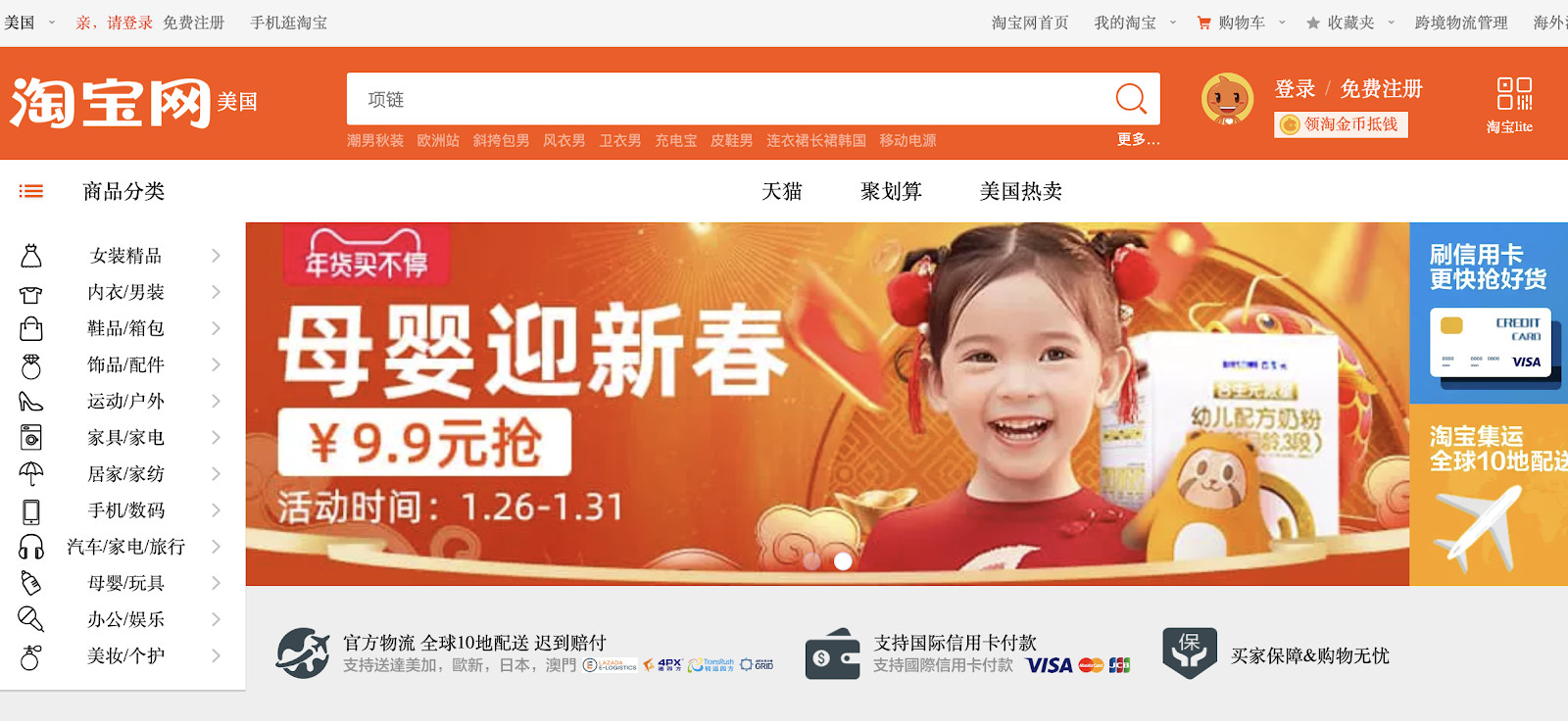 A collage of a smiling child in a red T-shirt, a soft toy, and red carp.
A collage of a smiling child in a red T-shirt, a soft toy, and red carp.
Alt text: Taobao collage featuring a smiling child in a red T-shirt, a soft toy, and red carp, representing its focus on the Chinese market and diverse product offerings in the world’s largest online marketplace.
Taobao, launched in 2003, has become the largest online marketplace globally by gross merchandise value. This Chinese online selling site boasts an enormous scale and product variety, catering primarily to the Chinese consumer market.
OTTO
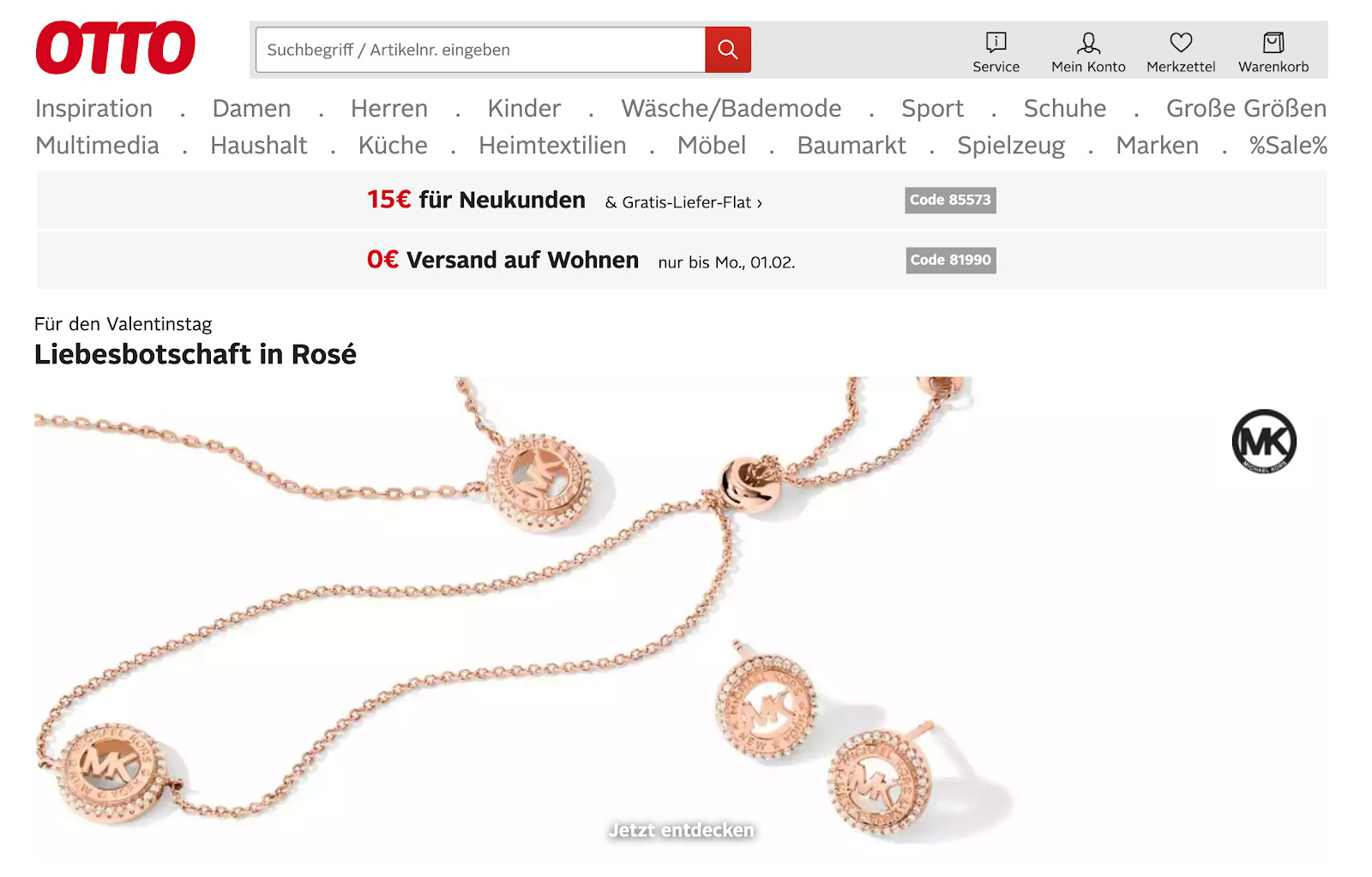 Rose gold pendants inscribed with the letters “MK”.
Rose gold pendants inscribed with the letters “MK”.
Alt text: OTTO product image featuring rose gold pendants with “MK” inscriptions, showcasing its focus on fashion and lifestyle products as a major online retailer in Germany.
OTTO, based in Germany, is a leading online selling site with a strong emphasis on fashion and lifestyle products. Evolving from a post-war mail-order shoe company, OTTO has grown into a major e-commerce player with 11 million active customers.
Today, over 90% of OTTO’s sales occur online, encompassing both branded products and goods from third-party retailers, solidifying its position as a dominant online retail force in Germany and Europe.
Rakuten
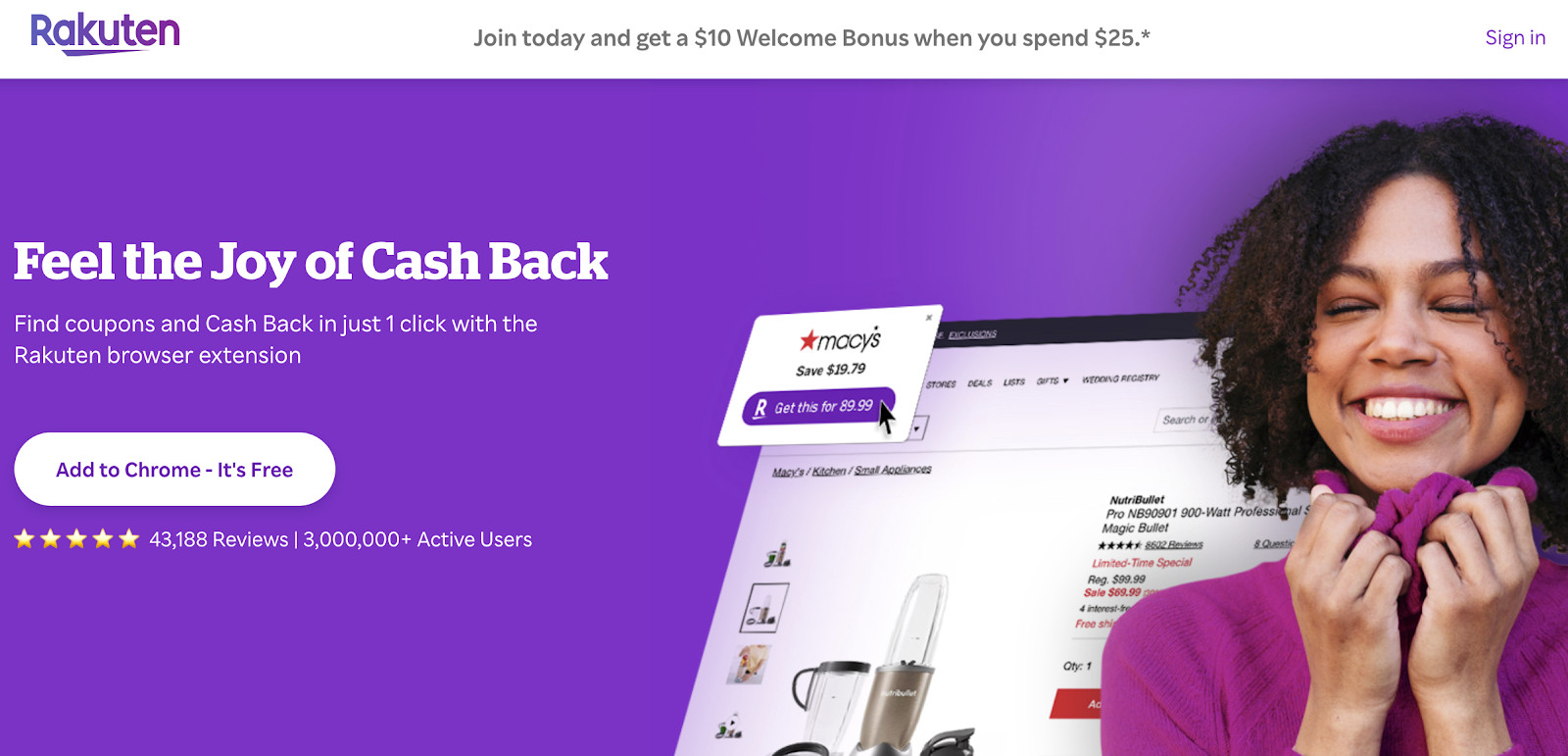 A pleased-looking person beside a webpage displaying a kitchen blender, on a purple background.
A pleased-looking person beside a webpage displaying a kitchen blender, on a purple background.
Alt text: Rakuten advertisement featuring a person next to a webpage displaying a kitchen blender, highlighting its wide product range and position as a major e-commerce and services platform in Japan.
Rakuten is a prominent Japanese marketplace offering a diverse range of services, including e-commerce, banking, and communications. Similar to Amazon, Rakuten supports selling across numerous product categories, from apparel and books to sports equipment and subscription boxes.
Businesses seeking to sell on Rakuten typically need to be registered in the United States or Japan or partner with a Rakuten-approved service provider to facilitate marketplace access and operations.
Mercado Libre
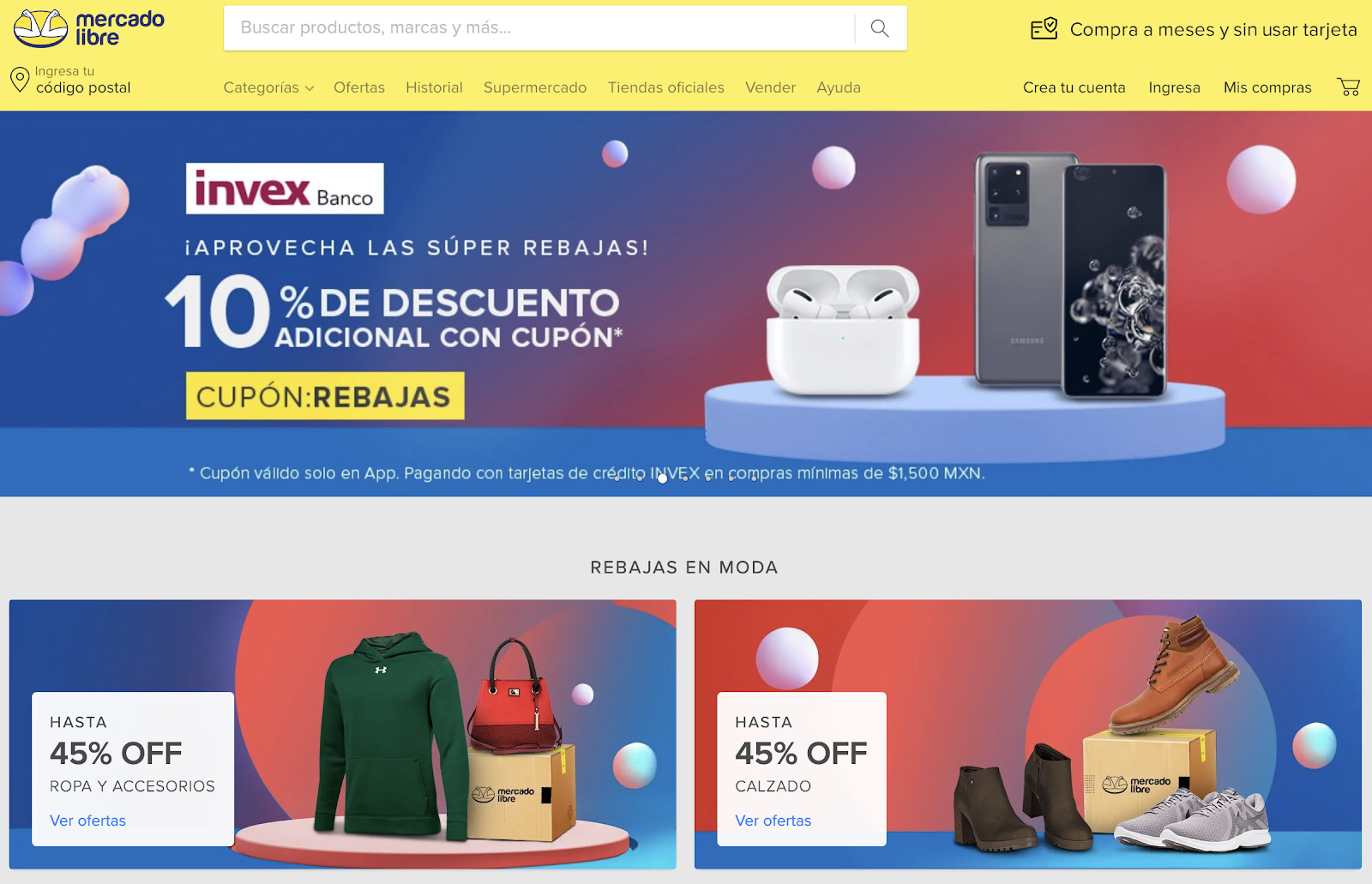 Apple AirPods and a Samsung Smartphone on a blue podium.
Apple AirPods and a Samsung Smartphone on a blue podium.
Alt text: Mercado Libre product display featuring Apple AirPods and a Samsung Smartphone on a blue podium, showcasing its focus on electronics and status as the leading e-commerce marketplace in Latin America.
Mercado Libre is the leading ecommerce marketplace in Latin America, serving over 18 countries in the region. Sellers on Mercado Libre offer products spanning 20 main categories and 123 subcategories, making it a comprehensive platform for reaching Latin American consumers.
Flipkart
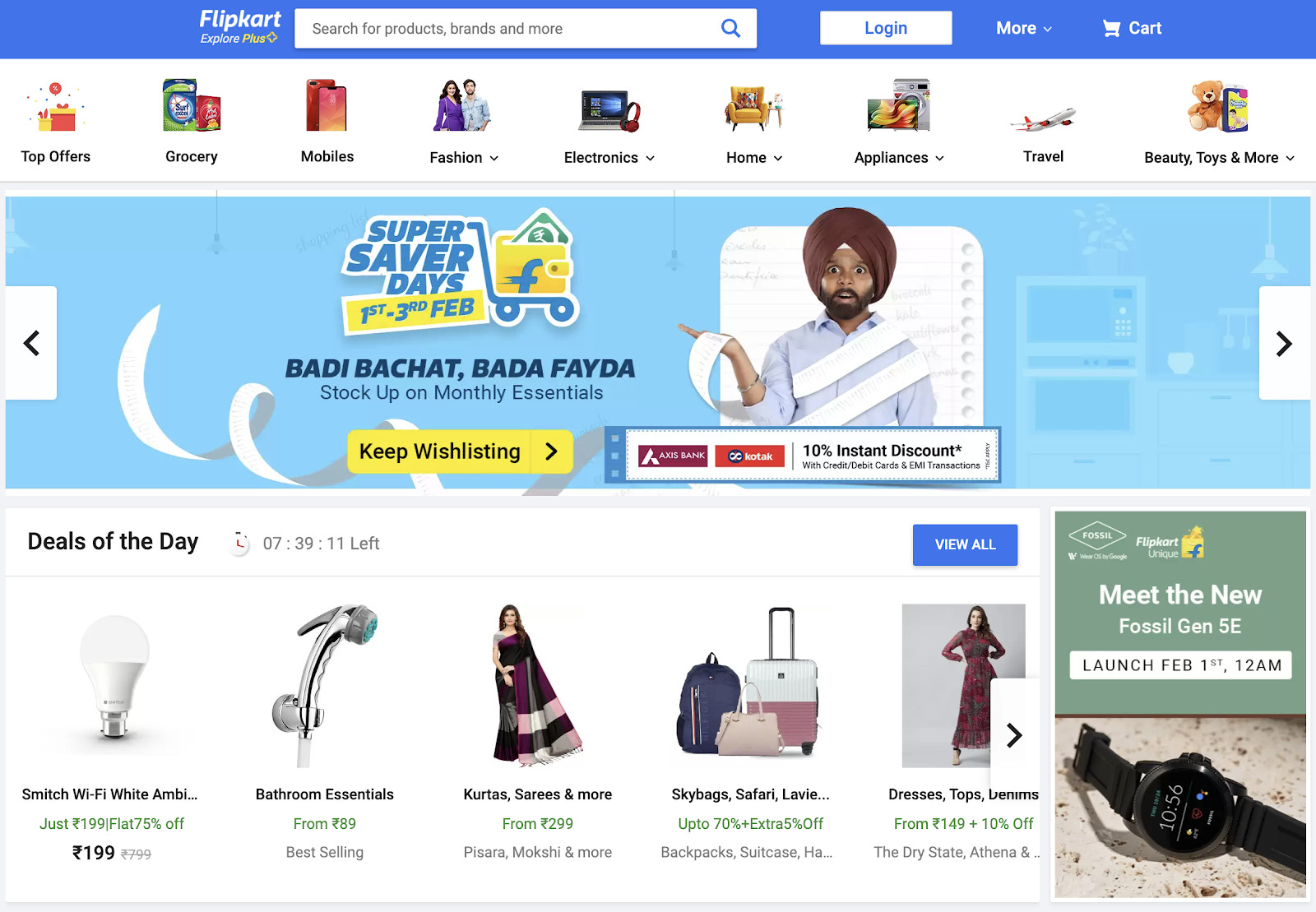 A shocked-looking person wearing a turban and a blue shirt holding a long receipt.
A shocked-looking person wearing a turban and a blue shirt holding a long receipt.
Alt text: Flipkart advertisement featuring a person in a turban holding a long receipt with a shocked expression, emphasizing its position as the largest online selling site in India and focus on customer experience.
Flipkart began as an online bookstore in 2007 and has evolved into the largest online selling site in India. Competing directly with Amazon in the Indian market, Walmart-backed Flipkart maintains a leading e-commerce market share, offering a vast array of products including electronics, fashion, home goods, groceries, and lifestyle items.
MyDeal
 A banner ad for bed sheet sets below a navigation menu and search bar.
A banner ad for bed sheet sets below a navigation menu and search bar.
Alt text: MyDeal banner ad for bed sheet sets displayed below a navigation menu, illustrating its focus on home and living product categories as a prominent Australian online marketplace.
MyDeal is a major Australian marketplace offering over one million products across 3,500 categories and attracting over two million visitors monthly. MyDeal operates exclusively as a marketplace, featuring products from third-party sellers without selling its own inventory.
While supporting diverse product categories, MyDeal is particularly strong in furniture, homewares, and large-item sales. Sellers on MyDeal are responsible for managing their own fulfillment and shipping logistics or utilizing external logistics providers.
Sell Internationally in Minutes with Shopify Markets
Shopify Markets empowers you to expand your business globally, selling to multiple countries from a single Shopify store. Streamline store localization, shipping, duties, and compliance management in one unified platform.
Find the Best Online Selling Site Strategy for Your Business
Every online business, whether operating a dropshipping venture or selling custom-made products, should strategically explore various online selling sites. Marketplaces can be invaluable for launching new businesses, providing immediate access to active buyer communities and built-in marketing opportunities.
However, relying solely on online marketplaces can limit brand building and profitability. Establishing your own online store is crucial for cultivating brand identity, fostering direct customer relationships, and maximizing profit retention. With a dedicated online home base, you can minimize commission and fee payouts to external platforms and build a sustainable business for long-term growth. Ultimately, the most effective online selling strategy often involves a balanced approach, leveraging marketplaces for reach and your own store for brand ownership and profit optimization.
Illustration by Rachel Tunstall
From entrepreneurs starting their first online venture to established global retailers, Shopify provides scalable solutions for businesses of all sizes. See plans and pricing.
Read More
Selling Sites FAQ
How can I start selling online?
- Create your own online store: Utilize an e-commerce platform like Shopify to build a branded online store.
- Become a marketplace seller: Register as an individual seller on established platforms like Amazon, eBay, or Etsy.
- Sell on social media: Leverage social media platforms such as Facebook and Instagram for direct sales.
- Launch a dropshipping business: Explore the dropshipping business model for inventory-free online selling.
- Sell used goods: Utilize resale apps like Decluttr or VarageSale to sell pre-owned items.
What are the best websites for selling stuff online?
- Your own store (built with Shopify or similar platform)
- Amazon
- eBay
- Etsy
- Bonanza
- Facebook Marketplace
- Rakuten
- Faire
- Poshmark
Where can I sell my stuff online for free?
- Facebook Marketplace
- Nextdoor
- VarageSale
What is the best site to sell stuff locally?
- Facebook Marketplace
- Craigslist
- Nextdoor
- VarageSale
- OfferUp
- Poshmark
- eBay
- Vinted
- Decluttr
